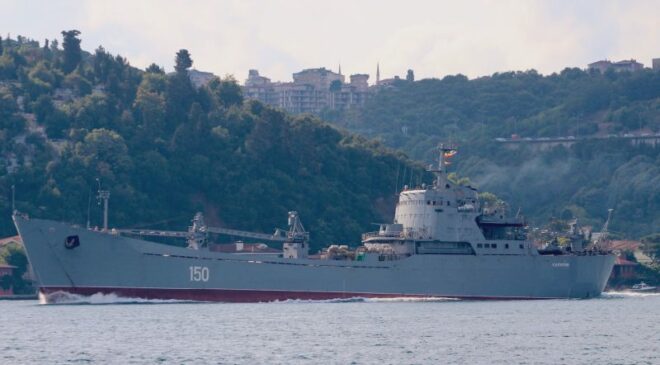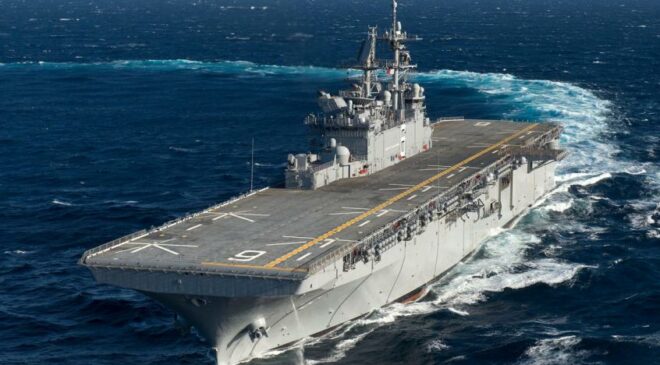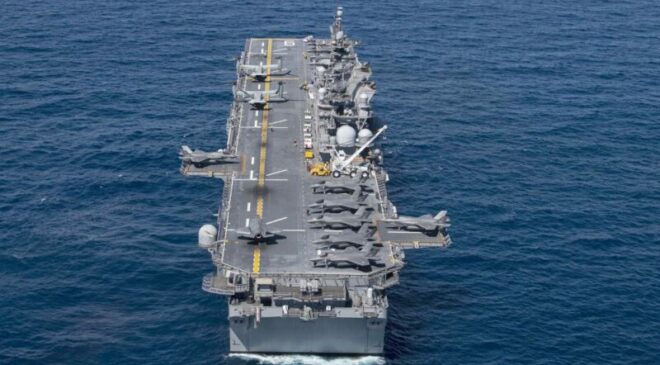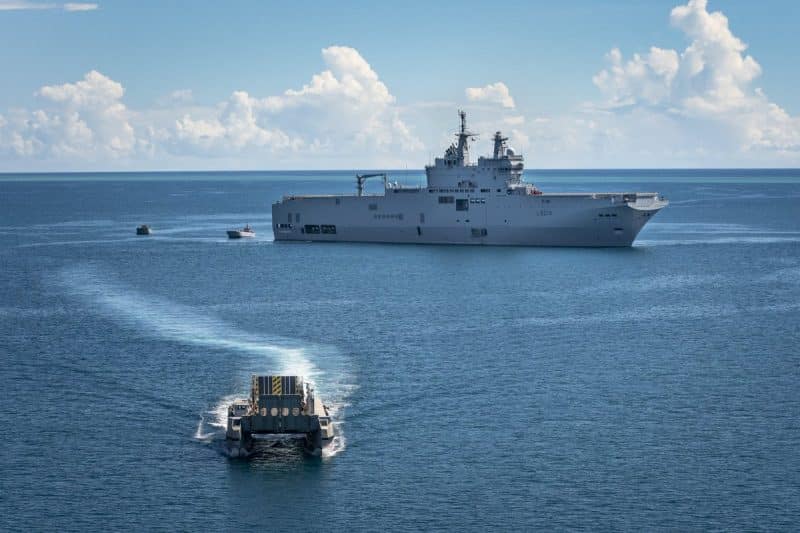In this section:
Although amphibious operations are, compared to land, naval and even air battles, few in history, they often had a considerable impact on the course of conflicts.
Whether it be the Torch (North Africa), Overlord (Normandy) and Dragoon (Provence) operations against Nazi Germany, the American landings on the Pacific islands facing Japan, or that of Inchon during the Korean War, all helped to reverse the balance of power and considerably influenced the conduct of the war.
Conversely, some failures, such as the Anzio landing in Italy, or that of the Dardanelles during the First World War, led to a critical stagnation of the military effort, as well as unbearable losses.
The last large-scale aero-amphibious operation took place in Port Carlos on May 21, 1982, and enabled the Royal Navy to land 4000 British soldiers for the reconquest of the main island of the archipelago, at the cost of two sunken frigates, HMS Ardent and Antelope, two damaged destroyers, HMS Brilliant and Argonaut, as well as several logistics units which were badly damaged, RFA Sir Galahad, RFA Sir Lancelot and RFA Sir Tristan, under the bombs of the A4 Skyhawks and Dagger of the Argentine Air Force.
The Falklands War saw the Royal Navy's two helicopter carrier assault ships, HMS Fearless and Intreprid, shine in particular. land with their gear using Wessex landing craft and helicopters.
Since then, the context of amphibious assaults has evolved considerably, in particular due to the proliferation of coastal batteries armed with anti-ship missiles capable of autonomously reaching naval targets within a radius of 40 to 50 km, depending on their elevation, far beyond with the support of remote location systems, such as aircraft, drones or ships/submarines.
It is in particular this threat, as well as the presence of numerous underwater mines, which prohibits the Russian fleet from carrying out an amphibious assault on Odessa in Ukraine, which to date only has LST-type buildings. forced to approach the coast and beach to lead the assaults.
In order to respond to this new threat, the US Navy designed, in the late 60s, the first class of assault helicopter carriers, the Tarawa class, capable of carrying out an assault simultaneously using fast barges and heavy transport helicopters, if necessary escorted by combat helicopters, while remaining under cover of the horizon and therefore of enemy anti-ship missiles.

254 meters long for a tonnage of more than 40.000 tons in load, the Tarawa not only had a vast hangar and a raft to implement a fleet of landing craft and other assault hovercraft, but also a very large aeronautical hangar capable of accommodating more than twenty CH-53 Sea Station and CH-46 Sea Knight heavy helicopters, as well as a right flight deck of almost 9000 m² and two elevators to implement these aircraft with a very sustained aerial rotation rate.
Later, the Tarawa, which had little to envy to the Essex-class aircraft carriers of the Second World War, will see part of their helicopters replaced by Harrier fighter planes so as to increase their firepower and the support capabilities of the forces engaged in the amphibious assault.
Since then, the concept developed by the Tarawa class has had a following in many navies, including the US Navy which subsequently developed the Wasp class and recently the America class to maintain this advanced capability, but also the French Navy with the class Mistral, China with the Type 075 and Italy with the new Trieste class, these ships being covered in this article.
A second article will cover Spain with the prolific Juan Carlos I class, Turkey with Anadolu, South Korea with the Dokdo and Russia with the upcoming Ivan Rogov class.
United States: LHA class America
Direct heirs of the Tarawa and the Wasp of the US Navy, the LHA (Landing Helicopters Assault) of the America class take up the main characteristics with a length of 257 meters for a maximum width of 32 meters and a displacement of 44.000 tons in load. , that of the French nuclear aircraft carrier Charles de Gaulle.
The first two ships of the class, the USS America and USS Tripoli, which entered service in 2014 and 2020 respectively, are as such dedicated to the implementation of aircraft, heavy transport helicopters CH-53 Super Station, helicopters of attack AH-1 Viper or MH-60 Knighthawk utility helicopters, but also heavy convertible MV-22B Osprey aircraft as well as AV-8B Harrier II then F-35B Lighting II combat aircraft with vertical take-off and landing or short, all of which are implemented by the United States Marine Corps.
In total, the ship can carry more than 25 aircraft, and experiments seem conclusive have even been carried out to assess the potential of these two buildings to play the role of light aircraft carrier by carrying around fifteen F-35Bs, i.e. as many as many specialized aircraft carriers.

The 9 other ships of the class, from the USS Bougainville, the construction of which began in March 2019, are equipped with a raft allowing the implementation of rapid landing units LCAC (Landing Craft Air Cushion), a hovercraft 27 meters long and 14 m wide capable of carrying 60 tons of cargo at 40 knots over a distance of more than 200 nautical miles.
In addition to the write-off, the future ships of the class will also have a field hospital three times larger than that deployed on board the America and the Tripoli, for which numerous concessions have been made in order to increase the implementation of aircraft.
Unlike the Wasp, the America class ships use propulsion based on two gas turbines of 70.000 horsepower each, supported by two auxiliary turbines of 5000 hp, allowing them to sustain a speed of 20 knots.

Beyond the amphibious aspects relatively close to those of the Wasp and Tarawa which precede them, the Americas were designed to implement the F-35B Lighting II, an aircraft which for the first time gave the US Marine Corps the ability to s to seize air superiority over the landing zones, but also to ensure the protection of the assault fleet without having to resort to a US Navy aircraft carrier for this purpose.
The bridge was thus specially designed to absorb the extraordinary heat release of the F-135 turbojet engine during short take-off or vertical landing maneuvers of the aircraft, while having six landing spots for helicopters.
Finally, the ship's self-defense capabilities are significant with 2 RAM CIWS each armed with 24 very short-range missiles, 2 20mm Phalanx CIWS as well as two Evolved Sea Sparrow ESSM short-range anti-aircraft missile launchers and several systems of small calibers.
China: LHD Type 075
At the beginning of the 2000s, the People's Liberation Army Navy had a very large assault fleet made up of 28 Type 072 tank transports (4200 to 4800 tons) and around fifty LST Type 073/ 74 from 700 to 2000 tons.

75% of this article remains to read,
Subscribe to access it!
The Classic subscriptions provide access to
articles in their full version, and without advertising,
from 6,90 €.
Newsletter subscription
Register for the Meta-Defense Newsletter to receive the
latest fashion articles daily or weekly


[…] marines and their materiel is provided by US Navy ships, using Wasp and America class LHD/As and San Antonio and Whidbey Island LPDs, carrying a self-contained amphibious expeditionary force […]
[…] we saw in the first part of this article, the assault helicopter carriers, a hybrid ship combining a powerful capability […]
[…] The Italian Navy has become, for fifteen years, the priority of Rome's military effort, so as to make it not only the most powerful naval force in the Mediterranean basin, but also in many aspects, from old continent, surpassing the French Navy and the very powerful Royal Navy in this area. To do this, Rome relies on the very dynamic industrial group Fincantieri, and on sustained investments. Thus, since 2007, the Marina Militare has admitted to service 2 anti-aircraft destroyers of the Horizon class, 8 FREMM frigates of the Bergamini class, 3 heavy patrol boats equivalent to PPA frigates of the Thaon di Revel class, the large logistics ship Vulcano as well as aircraft carriers Cavour and Trieste. […]